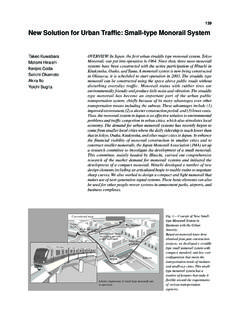Transcription of About Escalators Part of the urban landscape - Otis …
1 About Escalators part of the urban landscape Visit any large department store, shopping mall, metro station, airport or stadium anywhere in the world and you are sure to find Escalators carrying people quickly and safely to their destination. The escalator has become an integral part of the urban landscape . While passenger elevators were in common use since the 1870s, it was not until 1899 that the Otis Elevator Company introduced the world's first commercially successful moving stairs. Otis Elevator Company has been safely and efficiently moving people for 150 years.
2 Otis is the world's largest manufacturer of elevators, Escalators , moving walks and people movers. With million instal- lations, 61,000 employees, and operations in more than 200 coun- tries, it's safe to say that the world rides on Otis. About Escalators 1 of 7. The rise of the modern escalator Although there had been several attempts to design and build moving stairway systems prior to 1899, none proved safe or practical enough to come into general use. It was not until that year when the Otis Elevator Company built the first step-type escalator that the idea became commercially feasable.
3 This original Otis design remains the basis for the escalator as we know it today. The word escalator was coined by combining the Latin word for steps scala with the word elevator. The term remained a reg- istered trademark of the company until 1950, when the Patent Office ruled it was in the public domain since escalator had become the generic name for a moving stairway. The Paris Exposition of 1900. featured the first step-type escalator for public use. Early step-type tread at the beginning of the rise.
4 About Escalators 2 of 7. Finding a safer solution Designing a safe transition point where passengers step on and off the escalator was one of the major problems in creating a successful moving stairway. A. number of methods had been attempted before Otis solved the problem. In one earlier design, as the moving steps reached the upper landing, they disappeared under a V shunt. The purpose of the shunt was to literally shove passengers off the stairs and onto the landing. This required them to take an awkward sidestep with one foot while the other foot was still traveling forward.
5 This called for considerable concentration and coordination on the part of the passengers . a difficult enough feat at the best of times, much less when one was burdened with parcels or attending small children. Another alternative was a system that employed a series of comb- like prongs that lifted the passengers' feet off the treads when they reached the top. The prongs were designed to mesh with the tread cleats at the end of the ascending and descending runs. This was an improvement over the awkward V shunt system, but the 30 40 cm (12-16 in) prongs still posed a hazard.
6 Passengers were tempted to leap over the approaching prongs rather than risk being scooped off. Neither the awkward V shunt system nor the pronged-comb solu- tion was practical for the majority of users. Otis solved the problem of the transition point by combining the moving tread with a much safer comb and cleat design that reduced the prongs to a safer, tapered length. At this point, escalator sales began their steady climb. In its first year with the newly designed escalator, Otis sold more units than it had in the previous 20 com- bined.
7 Its time had finally come. 1. 1. Escalators came into use in the public transportation sys- tems of both New York and London soon after their intro- duction. 2. V-shunt assembly 3. Early comb plate design 4. Top landing at Macy's department store, New York City 2. 3 4. About Escalators 3 of 7. The pursuit of innovation Otis, in its tradition of innovation, has continued to refine the escalator since it pioneered its introduction. Handrails Early Escalators had solid rubber handrails driven by metal chains.
8 The chains traveled in a lubricated steel channel. The result was that passengers often wound up with oil-stained hands or gloves. Otis replaced this design with a tension-driven rubber and canvas handrail that was guided in a simple unlubricated channel. Later, Otis refined this design by introducing pinch-resistant handrails to prevent the possibility of passengers' fingers from getting caught. Another Otis innovation was to extend the handrails 40 cm (16 in). beyond the point where the steps disappear at the landings.
9 This simple design improvement dramatically increased escalator safety. The extended handrail permitted passengers to grasp the rail and steady themselves before stepping onto the moving stairs. It also aided them when stepping off. The extended design improved safety by making it difficult for hands to get caught at the point where the handrail disappears into the guide box. Handrail ergonomics is an important measure of ride quality. Today, Otis employs rigorous engineering and quality control to ensure the precise synchronization of the step and handrail assemblies, improv- ing both safety and comfort.
10 Machine Handrail Balustrade Comb Plate Step Skirt Panel Landing Floor Plate Handrail Guide Box About Escalators 4 of 7. continued The pursuit of innovation Steps and landings Early Escalators had wooden steps. Otis changed to cleat-type die- cast metal steps in the 1930s. Later, it introduced narrow-gauge step-type cleats. At the landing, the early comb prongs were 30 40. cm (12 16 in). Today, they are only 19 mm (3/4 in) long. Modern cleated risers are designed to prevent the pinching hazard when the steps move back into the platform at the top landings.











